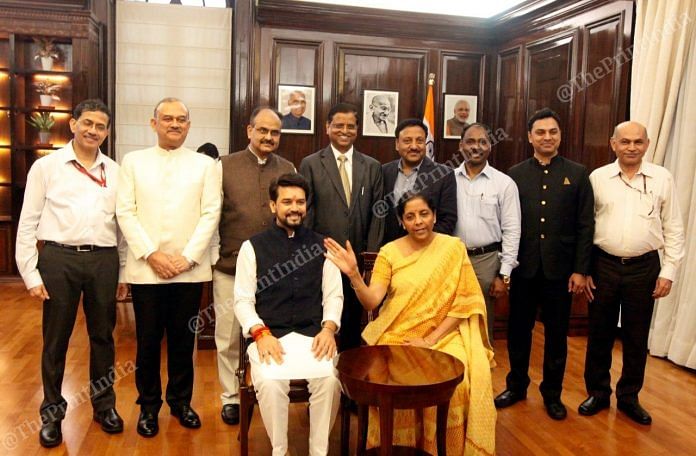New Delhi: The biggest challenge facing Finance Minister Nirmala Sitharaman as she presents her first budget Friday is reviving investment and consumption to arrest economic slowdown while also maintaining fiscal deficit projections for FY20.
The government had set a fiscal deficit target of 3.4 per cent for FY20 in the interim budget. But the magnitude of economic slowdown was still not predicted then.
Data released by the Central Statistics Office subsequently had showed how the Indian economy was growing at a five-year low of 5.8 per cent in the last quarter of 2018-19. The full-year growth in FY20 had also slowed for the second consecutive year — from 7.2 per cent in 2017-18 to 6.8 per cent — led by a sharp slowdown in private consumption, especially in rural areas. In 2016-17, it was 8.2 per cent.
With a sluggish economy and uneven distribution of monsoon likely to impact agricultural growth and further shrink rural incomes, economists believe that the government may have little option but to provide a fiscal stimulus and brokerages.
Also read: Finance Minister Nirmala Sitharaman is new to the job – but faces age-old problems
Fiscal deficit target, unemployment and rural distress
Abheek Barua, chief economist at HDFC Bank, said, “Growth slowdown has been worse than anticipated, warranting a fiscal push to revive the economy. Lower growth also implies downside risks to revenue targets of the government for FY20.”
Financial services company Angel Broking, in a note Thursday, said that given the severity of crisis in non-banking financial companies (NBFC) sector, explanatory fiscal and monetary policy is the need of the hour. It also said that markets have factored in a decline of 10-20 basis points in the fiscal deficit.
“Given the stressed revenue situation, the government faces a tough trade-off between sticking to its fiscal consolidation target and providing fiscal stimulus. If the government decides to give a higher weightage to growth and expand its fiscal deficit target, interest rates are likely to be impacted in the form of higher bond yields. This is what we call the trilemma — pushing for growth while keeping a check on fiscal consolidation and borrowing costs,” Barua said.
Soumya Kanti Ghosh, group chief economic advisor at State Bank of India, said there there is a “40% probability” of fiscal deficit for FY20 remaining at 3.5-3.6 per cent.
“The market will actually be happy with such numbers given the weaker growth impulses,” he added.
Also read: Budget is Modi’s big chance to boost India’s waning economy
There are also expectations that the government will resort to off-budget borrowings and use the National Small Savings Fund to keep the fiscal deficit low.
“One way to meet the fiscal deficit target, at least optically, is for the government to resort to other sources of financing — NSSF, off-budget expenditure through public sector enterprises and rollover of expenditure. This could provide some support to economic growth. But even in such a case there could be some upside impact on bond yields as the market could see through this window dressing,” Barua said.
The budget will also be keenly watched for measures to generate employment. Unemployment rate has reached a 45-year-high of 6.1 per cent, with job loss in the age group of 15-29 years at 17.8 per cent.
Rural distress may be another focus area of the budget though the Union cabinet has already cleared expansion of the PM Kisan scheme to more farmers.
The Economic Survey tabled Thursday had also flagged the impact of delayed monsoon on crop production and the rural income-demand scenario impacting economic growth.
Also read: Nirmala Sitharaman’s first budget should tell the truth about India’s economic crisis



